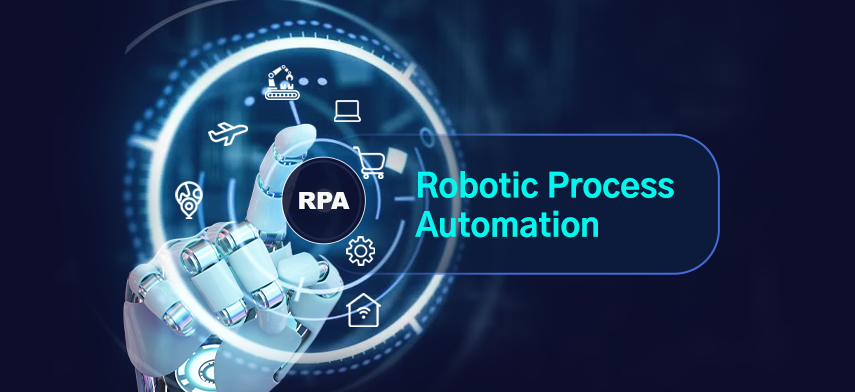
In today’s dynamic business landscape companies are constantly on the lookout for ways to enhance efficiency and cut down on costs. One groundbreaking technology that has garnered attention is Robotic Process Automation (RPA). RPA involves employing software robots or bots to automate tasks governed by rules freeing up human employees to concentrate on more strategic and value-added endeavors. This article delves into how RPA’s revolutionizing efficiency and reshaping the way businesses function.
Table of Contents
What Exactly is Robotic Process Automation?
Robotic Process Automation refers to a type of technology used in business process automation that utilizes software robots or bots to automate repetitive tasks. These bots are designed to emulate interactions with computer systems carrying out duties such as data entry, data extraction, and report generation among others. Robotic Process Automation technology can seamlessly integrate with types of software systems including legacy systems, web applications, and even virtual environments.

The Advantages of Robotic Process Automation
Integrating Robotic Process Automation can yield benefits, for organizations including;
1. Enhanced efficiency: By automating rule-based tasks Robotic Process Automation (RPA) allows employees to focus on strategic and value-added activities. This can result in time savings. Improved productivity.
2. Cost savings: Automating processes allows organizations to reduce the need, for intervention resulting in financial savings. RPA also eliminates errors and rework decreasing costs associated with processing.
3. Enhanced accuracy: RPA software meticulously follows predefined rules and instructions minimizing the risk of error. This leads to precision in tasks like data entry, calculations, and report generation.
4. Scalability benefits: RPA easily adapts to an organization’s needs by scaling up or down as required. It efficiently handles volumes of tasks without necessitating additional resources making it a cost-effective solution for organizations facing growth or demand fluctuations.
5. Compliance: Robotic Process Automation ensures that processes are executed consistently and in line with regulations and policies. It provides audit trails and logs that simplify demonstrating compliance during external audits.
6. Enhanced customer experience: Process automation enables organizations to streamline workflows and reduce processing times resulting in response times and increased customer satisfaction. Additionally, RPA facilitates interactions with customers while minimizing errors.
7. Improved analytics and reporting: Through capturing and analyzing data from sources RPA equips organizations, with insights and actionable information.
It can generate real-time reports enabling businesses to make data-driven decisions and improve their business intelligence.
8. Employee satisfaction: RPA eliminates repetitive tasks allowing employees to focus on challenging and rewarding work. This can result in job satisfaction improved morale and decreased employee turnover.
9. Implementation: RPA can be implemented quickly compared to other automation technologies. It doesn’t require coding or significant changes, in IT infrastructure enabling organizations to reap the benefits of automation sooner.
10. Competitive advantage: By adopting RPA organizations can gain an edge by enhancing efficiency reducing costs and delivering superior customer experiences. It enables organizations to adapt to evolving business needs and stay ahead in a changing market.
Use Cases of Robotic Process Automation
Robotic Process Automation finds applications across industries and business processes. Some common examples include;
1. Accounting: RPA automates tasks like processing invoices managing accounts payable/ generating reports minimizing errors and improving efficiency.
2. Human Resources: RPA streamlines processes such, as employee onboarding, payroll management, and benefits administration saving time and reducing burdens.
3. Customer Support: RPA can be utilized to handle customer inquiries, process orders and manage customer data resulting in response times and an enhanced customer experience.
4. Supply Chain Management: RPA has the potential to automate tasks associated with inventory management order processing and logistics leading to improved efficiency and cost reduction.
5. Healthcare: RPA can be implemented in billing, patient record management, appointment scheduling, and insurance claim processing ensuring accuracy while enabling healthcare professionals to devote more time to patient care.
6. Manufacturing: RPA can automate tasks involved in production planning, quality control, and inventory management within the manufacturing industry. This automation leads to increased productivity and a decrease, in errors.
7. Retail: By automating tasks such as inventory tracking, pricing updates, and order fulfillment through RPA technology retail businesses can enhance their efficiency. Improve customer satisfaction.
8. Insurance: With the help of RPA technology tasks like claims processing, policy underwriting, and fraud detection within the insurance sector can be automated. This results in improved accuracy and faster response times.
9. Telecom and Utilities: In the telecom and utilities industries specifically RPA can streamline billing processes while also automating tasks related to customer service and network management. As a result of this automation effort comes enhanced efficiency along with reduced costs.
10. Legal Services: Through the implementation of RPA technology within services firms or departments document review procedures become more efficient while tasks such, as contract management or compliance tracking are automated. Leading to increased accuracy levels while simultaneously reducing manual labor efforts.

Here are a few instances where RPA can be applied in industries and business processes. The possibilities, for automation using RPA are extensive. Organizations can reap benefits by implementing it to streamline operations cut costs and enhance accuracy and efficiency.
The Future of Robotic Process Automation
The adoption of Robotic Process Automation is set to continue its growth in the coming years. According to a report from Grand View Research the global RPA market is estimated to reach $25.56 billion by 2027 with a growth rate (CAGR) of 40.6% from 2020 to 2027.
This rapid expansion can be attributed to factors. Firstly organizations across industries are realizing the advantages of integrating RPA. By automating mundane tasks businesses can boost efficiency minimize errors and enhance productivity. This not only saves time and resources. Also allows employees to concentrate on more strategic and value-added activities.
Secondly advancements in technology— intelligence and machine learning—have made RPA more sophisticated and capable than ever before. Nowadays RPA systems can handle tasks such, as natural language processing, data analysis, and decision-making. As a result of these advancements, the potential applications of RPA have expanded across functions and industries.
Moreover, the COVID-19 pandemic has sped up the acceptance of RPA. With the shift, to work and the necessity for business continuity companies resorted to automation to keep operations running smoothly and simplify processes. RPA has proven to be an asset in enabling work ensuring business resilience and minimizing disruptions.
As the market grows further there are trends anticipated to shape the future of RPA. One such trend is integrating RPA with emerging technologies like intelligence, machine learning, and natural language processing. This fusion of technologies, known as automation enhances the capabilities of RPA systems. Allows for more intricate and intelligent automation solutions.
Another trend involves making RPA more accessible to technical users through democratization. RPA platforms are becoming increasingly user-friendly and intuitive empowering business users to design deploy and manage automation processes without requiring coding skills or IT expertise. This democratization enables organizations to expand their automation initiatives while empowering employees to take charge of automation projects.
Furthermore, there is a rise in the adoption of cloud-based RPA solutions. Cloud-based RPA offers scalability, flexibility, and easy deployment options that make it an attractive choice, for organizations of all sizes.
Additionally, it allows for integration, with cloud-based applications and services thereby enhancing its automation capabilities.
CONCLUSION
In summary, the adoption of Robotic Process Automation is expected to experience growth in the years. With the market projected to reach billions of dollars and experiencing a growth rate, driven by the benefits of improved efficiency, technological advancements and the impact of the COVID 19 RPA is becoming an indispensable tool for organizations seeking to streamline their operations and remain competitive in a rapidly evolving business environment.
Robotic Process Automation is undeniably a game changer when it comes to efficiency. It provides organizations with a cost-scalable solution to automate manual tasks resulting in increased productivity, accuracy, and adherence, to regulations. As technology continues to progress we can anticipate RPA becoming more intelligent and capable of revolutionizing how businesses function.







